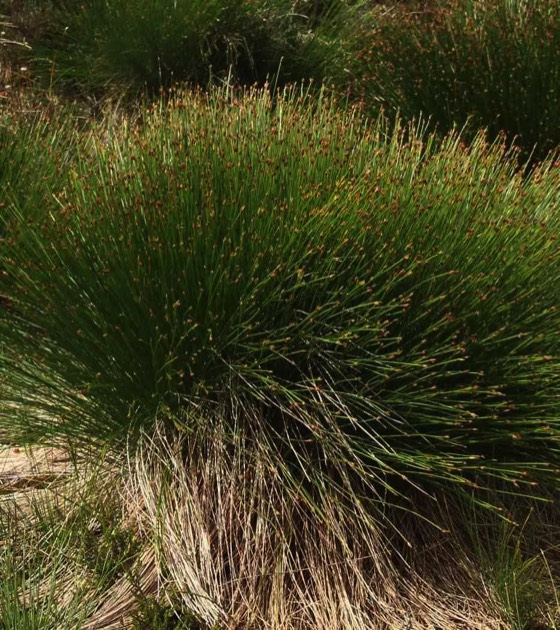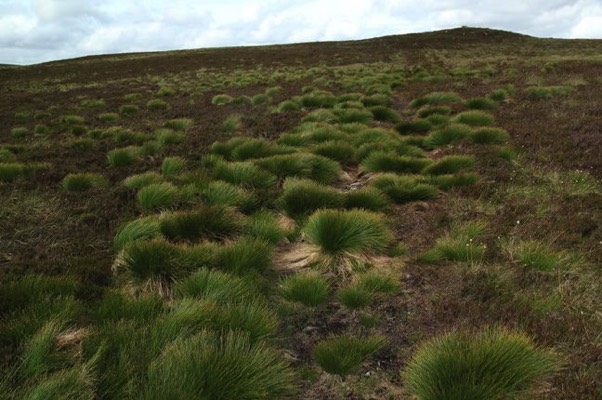SUMMARY ~
Trichophorum germanicum
Common Deergrass
Click one of the buttons below [wider screens only] for short summary accounts.
For the detailed pages, select from the drop-down menu in the top banner under 'Deergrasses', or from the sidebar [on narrow screens, it’s a bottom-bar!], or see the box of links at the base of the window [if visible].
Enter the name for this tabbed section: General

Most characteristic when making large, dense, and extremely tough tussocks, with the long stems splaying out.
Very variable: beware forms in seepage areas which can be almost as slender, and as open and 'wispy', as T. cespitosum, Northern Deergrass (see the ⇒Identification pages). Of course these small forms can be confidently identified by closer inspection.
The ⇒Hybrid Deergrass also can appear very similar – bridging the gap between the species – and you need to look more closely to separate them with confidence. Again, see ⇒Identification pages).
Enter the name for this tabbed section: ID
You can download a simple chart for *field identification* as a two-page A5 ⇓PDF (114 KB; opens in a new window).
See the dedicated pages, ⇒Field identification ~ 1 and ⇒ ~ 2 for much more detailed information.
Although externally similar, the two deergrass species are very distinct in their internal morphology, and readily separable: these are two good species!
Frustratingly, the widespread ⇒hybrid bridges the gulf between the two.
Remember that from July onwards the hybrid has ‘bare stem-tops’ at this time because it never ripens nuts, whilst the two species carry ripe nuts (but only if pollination has been successful! - in some seasons fruiting can fail over large areas).
The two species can be confirmed with a high degree of confidence by examination of their ⇒stem cross-sections.
See the dedicated pages, ⇒Field identification ~ 1 and ⇒ ~ 2 for much more detailed information.
Although externally similar, the two deergrass species are very distinct in their internal morphology, and readily separable: these are two good species!
Frustratingly, the widespread ⇒hybrid bridges the gulf between the two.
Remember that from July onwards the hybrid has ‘bare stem-tops’ at this time because it never ripens nuts, whilst the two species carry ripe nuts (but only if pollination has been successful! - in some seasons fruiting can fail over large areas).
The two species can be confirmed with a high degree of confidence by examination of their ⇒stem cross-sections.
Enter the name for this tabbed section: Habitats

Drier heath communities in particular are likely to harbour this species alone (rather than the hybrid or Northern Deergrass), although more work needs to be carried out to establish the limits of the hybrid's tolerances versus this species in UK.
In damper mire habitats, the hybrid is also likely to occur, and in some basin- and raised mires the hybrid greatly outnumbers either species.
The situation on blanket-bog is confusing, and I can offer little advice except to get out there and find out! Some disturbed blanket-bogs carry the hybrid; whether this reflects the former (or even present) occurrence of Northern Deergrass in nearby mires is unclear to me. In all cases, the hybrid will tend to follow seepage-lines.
See Andy Amplett's very clear note in BSBI News, No. 119, pp. 37–39 (January 2012), describing this species' habitats in Speyside, along with comments on the other two taxa.
Enter the name for this tabbed section: NVC
The publication of NVC communities (Rodwell et al., British Plant Communities, Vol. 2, 1991) pre-dated the clarification of the three deergrass taxa, and so the listing of 'Scirpus cespitosus' may not always refer to this species. The aggregate 'Scirpus cespitosus' is listed under no less than 22 'mire and heath' categories!
T. germanicum is a typical member of the mire communities M15 to M20, and also on upland heaths such as H10 and H12, and even high altitude U7.
(See A. Amphlett, BSBI News, No. 119, p. 37 (January 2012), here.)
T. germanicum is a typical member of the mire communities M15 to M20, and also on upland heaths such as H10 and H12, and even high altitude U7.
(See A. Amphlett, BSBI News, No. 119, p. 37 (January 2012), here.)
Links to other pages
Summary pages
Identification pages
Other information
